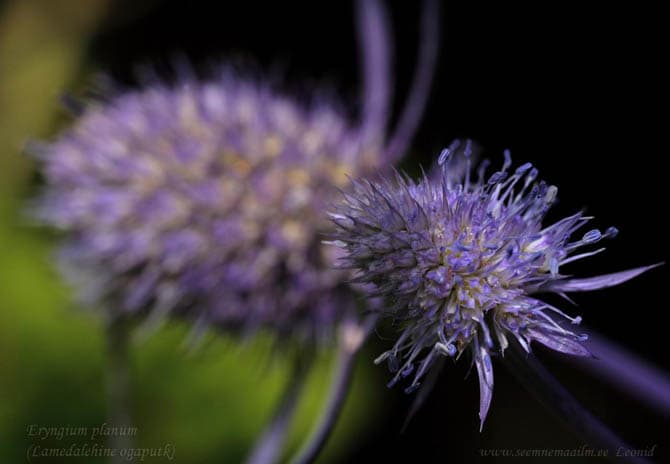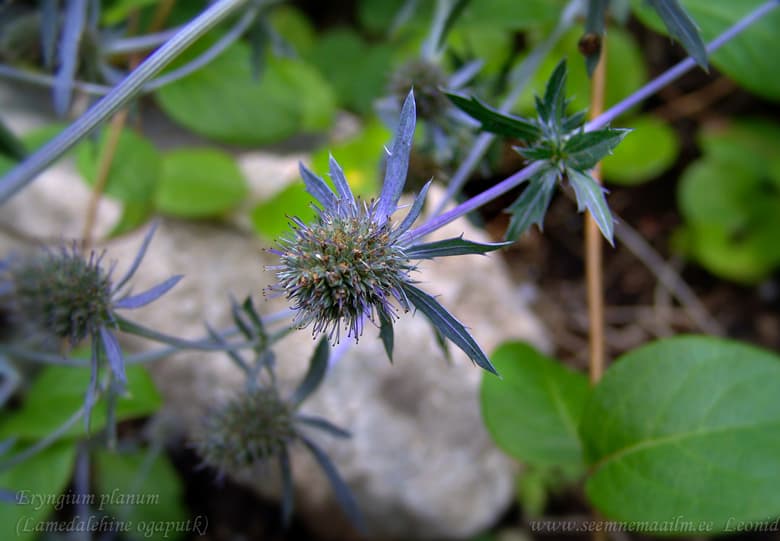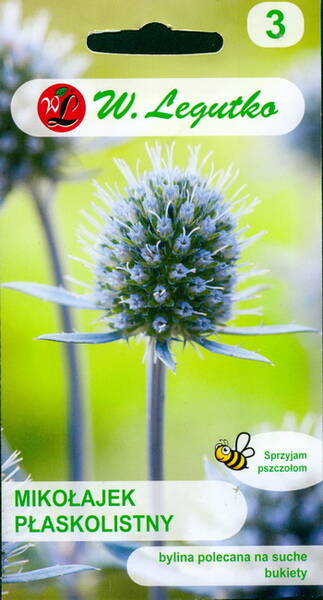Your shopping cart is empty!
Blue eryngo (flat sea holly)
Blue eryngo (Sea Holly) - Eryngium planum.
A perennial growing to 1.0 - 1.2 m.
It is hardy to zone 4.
It is in flower from July to August. The flowers are hermaphrodite (have both male and female organs) and are pollinated by Bees, flies and beetles.
The plant is self-fertile. It is noted for attracting wildlife. We rate it 1 out of 5 for usefulness.
The plant prefers light (sandy), medium (loamy) and heavy (clay) soils, requires well-drained soil and can grow in nutritionally poor soil.
The plant prefers acid, neutral and basic (alkaline) soils. It cannot grow in the shade. It requires dry or moist soil and can tolerate drought.
The plant can tolerate strong winds but not maritime exposure.
Requires well-drained soil and a sunny position. Prefers light sandy soil but tolerates most soil types including lime and poor gravels.
When grown in soils that are too rich the stems will need staking before they flop. Established plants are drought tolerant.
Plants are hardy to about -25 ° C. Plants should be put in their final position whilst small since they resent root disturbance.
A very ornamental plant, there are some named varieties. A good bee plant.
Propagation Seed - best sown as soon as it is ripe in early autumn on the surface of a well-drained compost in a cold frame.
The seed can also be sown in spring. It usually germinates in 5 - 90 days at +20 ° C.
When they are large enough to handle, prick the seedlings out into individual pots and grow them in the greenhouse for their first winter.
Plant them out into their permanent positions in late spring or early summer, after the last expected frosts.
Division in early spring or autumn. Take care since the plant resents root disturbance. Root cuttings in autumn or winter.
A profusion of steel blue flowers adorn this graceful Eryngium planum from mid-summer to fall. Will tolerate poor soil and dry locations, yet will thrive under many conditions.
Blue eryngo not like to be disturbed once established. Provides a distinctive architectural accent in the garden and is wonderful for dried arrangements.
A perennial growing to 1.0 - 1.2 m.
It is hardy to zone 4.
It is in flower from July to August. The flowers are hermaphrodite (have both male and female organs) and are pollinated by Bees, flies and beetles.
The plant is self-fertile. It is noted for attracting wildlife. We rate it 1 out of 5 for usefulness.
The plant prefers light (sandy), medium (loamy) and heavy (clay) soils, requires well-drained soil and can grow in nutritionally poor soil.
The plant prefers acid, neutral and basic (alkaline) soils. It cannot grow in the shade. It requires dry or moist soil and can tolerate drought.
The plant can tolerate strong winds but not maritime exposure.
Requires well-drained soil and a sunny position. Prefers light sandy soil but tolerates most soil types including lime and poor gravels.
When grown in soils that are too rich the stems will need staking before they flop. Established plants are drought tolerant.
Plants are hardy to about -25 ° C. Plants should be put in their final position whilst small since they resent root disturbance.
A very ornamental plant, there are some named varieties. A good bee plant.
Propagation Seed - best sown as soon as it is ripe in early autumn on the surface of a well-drained compost in a cold frame.
The seed can also be sown in spring. It usually germinates in 5 - 90 days at +20 ° C.
When they are large enough to handle, prick the seedlings out into individual pots and grow them in the greenhouse for their first winter.
Plant them out into their permanent positions in late spring or early summer, after the last expected frosts.
Division in early spring or autumn. Take care since the plant resents root disturbance. Root cuttings in autumn or winter.
A profusion of steel blue flowers adorn this graceful Eryngium planum from mid-summer to fall. Will tolerate poor soil and dry locations, yet will thrive under many conditions.
Blue eryngo not like to be disturbed once established. Provides a distinctive architectural accent in the garden and is wonderful for dried arrangements.


Sea Holly, blue eryngo, flat sea holly, plains eryngo.












